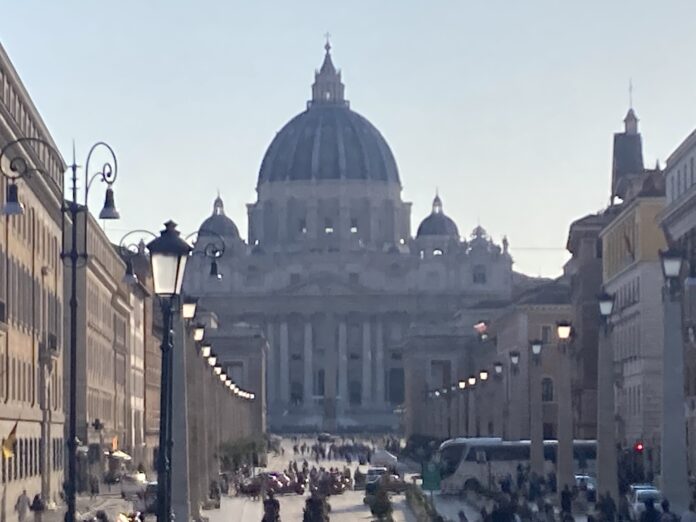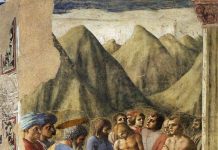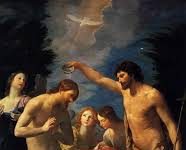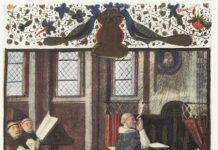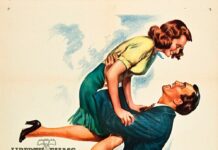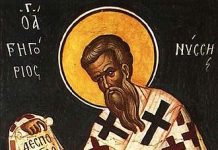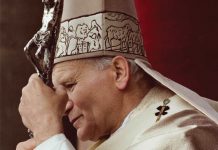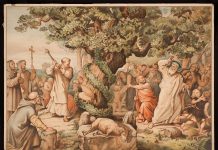On this feast of Saint Bridget of Sweden, one of the four co-patrons of Europe (along with Saint Benedict, Saint Catherine of Siena and Saint Teresa Benedicta of the Cross), it’s fitting to post this final reflection on my pilgrimage, on those last few days in Rome.
Rome, the Eternal City, the Centre of Christendom and the Catholic Church – all roads lead thereto, one way or another. I spent two full days there, as the culmination of this Jubilee pilgrimage, with two missions in mind: One, to walk through the Holy Door. I didn’t realize there was more than one of them (there are four) but I would at least make my way to the one at Saint Peter’s. Second, to travel by foot to the basilica of Saint Sebastian, the only one of the seven major basilicas which I had missed on my last visit to Rome. I thought I had gone to all of the seven major basilicas that time, but I presumed Saint Andrew’s was one of them. It’s not. It’s Saint Sebastian’s, which is way on the south end of the city along the Appian Way.
My visit to Rome began with getting off the train at Roma Termini from Assisi, and what a contrast it was: From the peace of that mediaeval place to chaos and noise and endless streams of people. I had an address for the convent-run hostel where I was staying, but only knew it was near the Vatican. So off I went, trudging through the baking heat of the late afternoon, hoping I would find it. I picked up some provisions, and stuffed them in my small backpack. I asked directions along the way, which is not something many do anymore. People were generally quite glad to help, even if I got a couple of ‘don’t you have Google maps?’ in broken English. I didn’t have data on my phone, deliberately, in part since that ruins the adventure. I knew the general direction, but after much trudging, the sight of Michelangelo’s elliptical dome was a great relief.
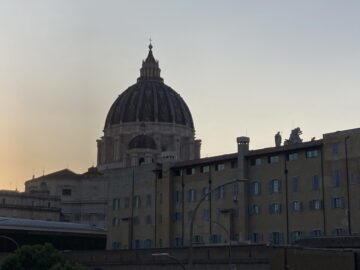
I realized that the place was on some side street that no one knew. A police officer vaguely pointed me in the right direction, and, in the end, a lovely young couple – a running theme on this pilgrimage – looked up the address on their phone, and pointed me to the right street, which I never would have found. I was at this point just across the road from the right road. So Google maps was used, since no one has real maps anymore. I should have brought my old one from many years ago.
Tired and sweaty – the latter a constant theme in Rome’s mid-summer – I was ready for a rest, and received a warm welcome from the Sister at the desk, a Pallotine, who run the hostel. Their Order was founded by Saint Vincent Palloti (1795 – 1850) whose incorrupt body lies in a church a half-hour walk away. The place included breakfast, and bottled water, both of which were life-savers. My room had a small balcony, on the second floor (what we would call the third floor here) from which I could just see the top of Saint Peter’s cupola.
The next morning was the feast of Our Lady of Mount Carmel, so I resolved to attend Mass at Santa Maria Maggiore, the primary church dedicated to the Mother of God. Again, I walked, asking directions now and again, and again got close. I discovered, like in Zurich, my phone would give my general location even without data, which was helpful indeed – for again, no real map; I picked up one of those all-but-useless tourist versions, upon which I splurged in some shop, but it served little purpose.
Finding the great basilica in time for Mass, I made my way through security – all the great basilicas have such – wondering what the long line up inside the church was for. To my faint surprise, I discovered it was people waiting to pay their respects, or just see, the plain, unadorned tomb of Pope Francis. I thought: Why couldn’t they just let people wander by, instead of cordoning them into a fake alley of sorts. Even though the tomb is out of sight except for those in the cordon, I knelt nearby and prayed for the repose of his soul.
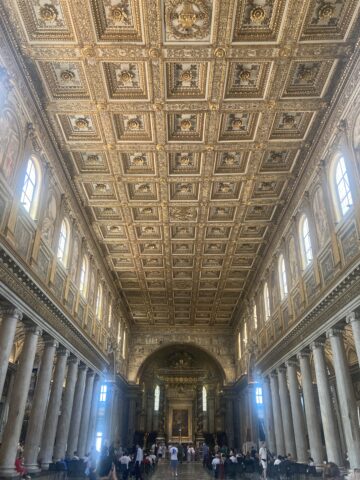
After Mass, and a bit of rest against a pillar, I went out into the blazing sunshine, to continue my way vaguely towards Saint John Lateran. The walks are made somewhat more bearable in Rome due to regularly-spaced fountains on the main thoroughfares, which gush forth fresh clean frigid water from some aqueduct or other.
The Lateran basilica is the Pope’s own proper church, and hence the foremost church in Christendom, invoking the Apostles, their larger-than-life statues dominating the nave. I prayed for the Church universal, Pope Leo and our bishops under the eyes of those Twelve chosen by Christ.
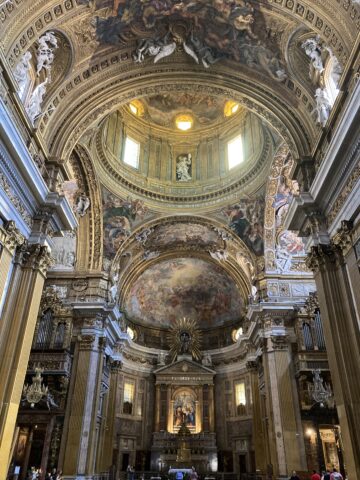
After that, just across the road, it was the Scala Santa, the actual steps that Christ ascended towards Pontius Pilate, brought to Rome by the Empress Helena. They are now covered in wood, but little windows allow one to see the original stone stairs underneath. One must ascend on one’s knees, and I did so with a large group, having to proceed at the pace of the row in front of me, which was slower than I liked, but perhaps just the speed I needed.
After the Scala, I thought I would head down to the Basilica di Santa Croce in Gerusalemme, which contains the most relics of the Passion of any church in Christendom, again brought to Rome by Constantine’s mother. Therein, one can venerate the nails, the thorns, the cross and the inscription in Latin, Greek and Hebrew placed above the dying Christ by Pilate. The place was not crowded at all, and it was edifying to see two young women, one of them handicapped, and perhaps one of their fathers spend a long time in prayer before the relics.
By this time, I was miles away, so decided to make my way back to my temporary home, stopping for some gelato – a necessary treat in Rome at least once. Thus refreshed, I thought I would take a look at the famous Trevi fountain, which was on the way.
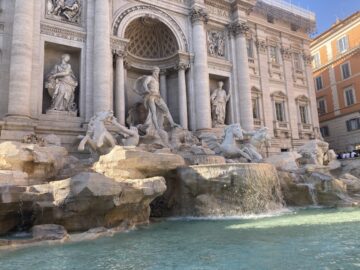
The place was so crowded, there was a line-up even to get near. I splashed my face in the clear water – the only one to do so, in the hot, late afternoon. I noticed a small church, so stopped in for a prayer. There were only a few people inside, and there to my left were the relics of Saint Gaspar del Bufalo (1786 – 1837), a Roman priest who founded the Missionaries of the Precious Blood, very fitting for this month of July dedicated to that devotion. He and his fellow priests evangelized the Italian countryside, especially the outskirts of the papal states rife with brigands, in those fraught and often lawless days before the unification of Italy. Mass was about to begin at 6:30. I thought of what those crowds just across the piazza at the fountain are missing. Here be the real treasure, the pearl of great price and true fountain welling up to eternal life.
My final day in Rome was spent getting to San Sebastian’s, to which I would get at least one way by foot. Again, it was blazing hot, but the route led by the edge of the Tiber, which offered at least some illusory coolness. I tried to find the church holding the incorrupt body of Saint Vincent Palloti on the way, and when I eventually did – it’s off a side alley and inconspicuous – it was locked up. So I prayed outside, and continued on.
I thought of trying to make it also to the Basilica of San Lorenzo fuori le mura – Saint Lawrence outside the walls – but realized it would be too much. There is a form of spiritual gluttony, an odd term which someone mentioned to me recently, but true enough. We can only do what we can do, and let God take care of the rest. My last visit to San Lorenzo was poignant, and I can keep that memory until another pilgrimage, Deo volente.
The route to Saint Sebastian’s led me to the outskirts of Rome, where there are tall, swaying palm trees. Eventually, one gets to a cobbled path, the ancient Appian Way.
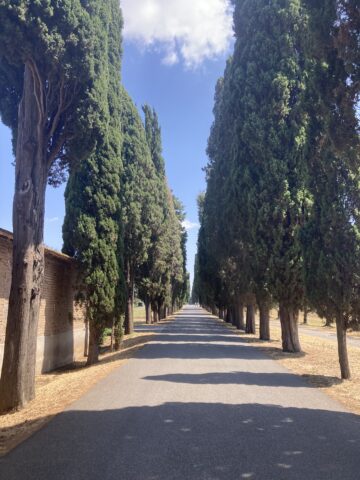
I had little idea how far it was, so just kept going, the route on my phone no longer functioning. Part way there, I came across a church, aptly named Santa Maria in Palmis, but also known as ‘Quo Vadis’. Inside, there is a bust of Henry Sienkiewicz, the author of the eponymous novel, one of the most famous ever written, a vast opera of characters in the time of Saint Peter and Nero.
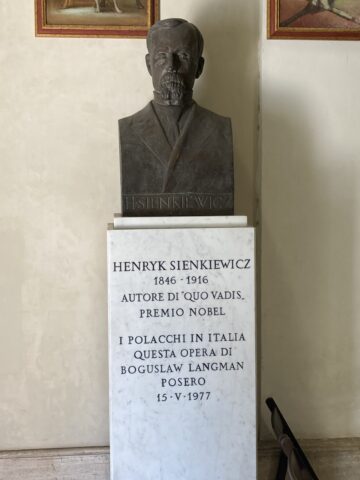
I discovered later that this commemorated the spot where Saint Peter, fleeing Rome, met Christ carrying His cross going the other way. Peter asked Him, ‘Quo vadis, Domine?’ to which Christ replied ‘Eo Roman iterum crucifigi’ – I am going again to Rome to be crucified’. Peter understood this as applying to himself, fulfilling Christ’s prophecy at the end of Saint John’s Gospel, that when Peter was older, others would bind him and lead him where he would rather not go. So back to Rome Peter went, and that has made all the difference.
I continued on, and finally made it to Saint Sebastian’s, in time for prayer, before the tour of the catacombs underneath the ancient basilica. These were where Saint Philip would pray at night, and where the second ‘Apostle of Rome’ received the Holy Ghost in the form of a ball of fire, which entered his chest, and expanded his heart, filling him with the fullness of His gifts. When they autopsied him at death, his hypertrophied heart had broken his ribs. I can’t say I received the same gift – but perhaps some small spark. I can only hope. Seeing the catacombs – one is given but a glimpse on such a touristy tour – offers a window into the life and devotion of the earliest days of the Church, which has always been Catholic in the fullest sense of that word. To those catacombs, one way or the other, we as a Church may have to return.
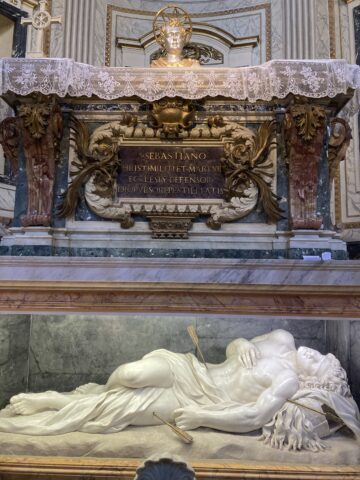
I paid my final respects to Saint Sebastian, whose body resides in a side altar, and caught the bus and subway home, for my final night in Rome. I met an older couple from Belgium, who spoke Flemish but whose English was very good, and who had never heard of the word ‘pilgrimage’. Perhaps there is some analogue in their language, but they seemed perplexed.
After a jostling ride on the Italian ‘Metro’, I made it back to my nido, and a repast on my balcony. I went for a late evening walk by the Tiber past Saint Peter’s, and past Castel San’Angelo (built as the mausoleum of Emperor Hadrian), at the end of the bridge of the same name, in which impregnable fortress Clement VII took refuge from the great pillage of Rome in 1527.
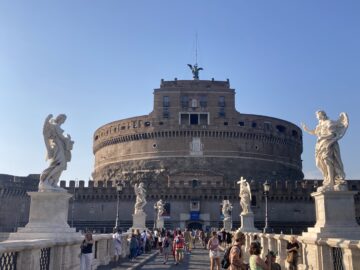
It was a lovely evening, watching the Tiber flow by, the crowds, the migrants selling their wares on the sidewalks – how could there be a market for so many leather handbags, toys, and trinkets? Seeing the lovers and dreamers and tourists in my solitary meanderings, I thought of earlier days in life, and what might have been. I suppose Rome does that, even in the midst of its noise and commercialism. I returned to Saint Peter’s by a circuitous route, praying a Rosary for the Church, ending off with Compline before the statues of the Apostles and Saints surrounding the great basilica.
I mentioned that Rome was the most difficult part of my journey, I might even say something of a scandal. Here, I should distinguish, with Saint Thomas. There’s active scandal, something that may cause one to sin. And there’s passive scandal, which is sinning because of that active scandal. For, of course, nothing can really ‘make’ you sin. Our wills are free, and we can choose. So active scandal is but a dispositive cause: It may dispose us to sin, but we can resist.
And resist I tried. I didn’t think it possible to sweat for three days straight, in a state of perpetual thirst. But such is Rome in July. The room I was given at the convent was pleasant, but with no air conditioning. I know, I know, a first world problem. But by cranking up the ceiling fin, and swishing the hot air around, one at least got the illusion of being less hot. Then there are the crowds, oh, the endless, streaming crowds. They do thin out as one gets farther from the Vatican, barring such tourist hot spots like the Trevi fountain or the Bocca della Verita, the mouth of truth, both made famous in films such as Roman Holiday and La Dolce Vita. Legend has it that the mouth will bite off the hand or arm of any liar, or at least anyone telling a lie. People were lined up to test the veracity of the story – as far as I could tell, all their limbs were intact. I could not tell if all of their consciences were also.
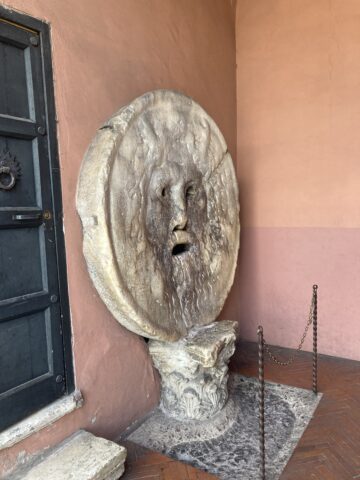
For me, the most disconcerting aspect was trying to get to the early Mass at Saint Peter’s. Allow me to explain: Pope Francis abolished nearly all private Masses in the basilica. One used to be able to walk in at any time of day (best in the morning), and find a Mass at one of the 44 altars in which one may join. Now, there are set Masses during day, on the hour, but the earliest is best – otherwise, one is stuck in a line-up that may last up to an hour. The problem is that the gates don’t open until 6:45, and then the police herds everyone through one, solitary metal detector to be checked.
The first morning, there was a large line-up already there just after 6 am. I discovered later that Thursday is ‘Polish day’. Although it was after 7 when I finally got into the basilica, I could join the Polish people for their Mass at the tomb of Pope Saint John Paul II, at the altar of Saint Sebastian, which was quite fitting. There were numerous priests in attendance. I didn’t understand much, but Mass is Mass.
The second morning, I was first in line, and no Polish people, so was through in jig time. However, when I got to the basilica, the Vatican employee hadn’t opened the large mediaeval gate to the Holy Door. He eventually came over – at about 6:53 – and instead of unlocking the gate, slowly put on an extra padlock. No eye contact, no words. There were now about a hundred people behind me, and this soul at least was frustrated that Mass was about to start – with no special Polish Mass to attend. I walked to the side and found an open gate, and I suppose some followed me. I went through the Holy Door – a second time – but not quite in a peaceful state. Why make people late for Mass, or even unable to attend? What is the whole thing about, if not for Mass? It’s why the gigantic, renaissance structure was built – to celebrate the Holy Sacrifice. As someone mentioned to me, the great basilicas have more or less become museums, and he’s not far off.
The Mass in its outward manifestation was fine, if nothing to write home about. Four older priests, the whole thing in Italian – which has in a practical sense become the Church’s official language. They did chant the Sanctus and Agnus Dei, in Latin, which I appreciated. They also sang a Marian motet at the end – if memory serves, the Ave Regina Coelorum, which they also did at Assisi. Why, I know not, as it is proper to Lent but, hey, I’ll take anything Latin and Gregorian at this point.
I did wonder why the traditional statue of Saint Peter was cordoned off. The custom used to be – and was until a few years ago – that pilgrims would rub the foot of the Apostle, as part of their prayer so that they’ve been rubbed down to little pointy elf feet. Now, no more, unless you want to hop the rope, and get huckled out by security. Perhaps the previous Pope thought the custom superstitious. There is a fine line between such and sacramental devotion, and I hope most Catholics fall into the latter, and not the former.
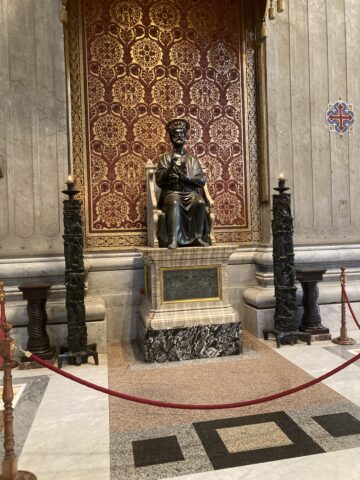
What is one to say at the end? Rome was, as mentioned, nearly the polar opposite of Assisi, but the two are in a deeper sense complementary – the Petrine and Marian dimensions of the Church, the contemplative and active, the hierarchical Church and the Church of the individual charisms – that is, the saints. Pope Innocent III in a dream saw Saint Francis holding up the Church, before he even met the poor man of Assisi, and there is much to that vision. It is the hidden sanctity that holds it all together.
All I can say is that I hope all those people that streamed past me in my pilgrimage are in some way seeking that holiness, even without fully realizing it, and I can only pray the same for myself. As Saint Francis put it, what a man is before God, that he is, and nothing more. We can say the same for the Church – in all of her external splendor, history and magnificence, what matters at the end of the day is whether she is saving souls.
The Catholic Church! As the troubled James Joyce put it, ‘here comes everybody’. Or in the more theological terms of Lumen Gentium, everyone either belongs to (pertinent) or is ordered to (ordinantur) the Catholic Church, which is the one, true religion, and which other religions approximate, some more, some less. Her nature and her mission is universal. If it is true that all roads lead to Rome, so too do they lead to Christ’s One, Holy, Catholic Church, if only people follow the truth where it leads, and do not fall into final despair, that sin against the Holy Spirit. For the only sin that cannot be forgiven is to refuse to seek forgiveness. As Pius XII put it, the greatest tragedy of our era is not so much sin, but the loss of the sense of sin, the darkening of the conscience, the hardening of the heart, and not to become the saint God intends us to be.
Beneath all her imperfections, the Church is the pure bride of Christ, His Mystical Body, and the source of all grace. If the tourists – and pilgrims, the two groups overlapping more than one might think – return home with just a touch of grace however unwittingly, it’s all worth it. A pilgrimage is not just for oneself, but for others, who may not be able to make such a journey. We must carry each other to heaven, each in our own way, taking the intentions and burdens, the joys and sufferings, of those who ask us to pray for them, and those who do not, to the limina of Christ, Our Lady and the saints, as we all continue on the pilgrimage of life. At the end of that journey, may we all meet merrily in heaven, where there is no sorrow, nor sweaty hot streets, but only joy everlasting, and the refreshing waters of eternal life.

